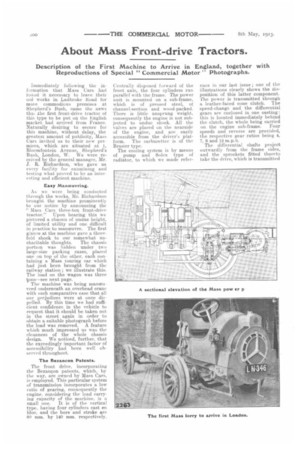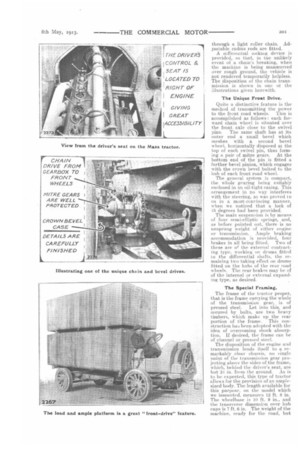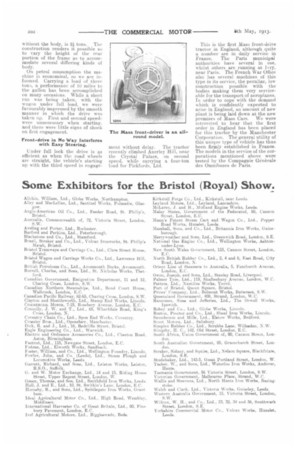About Mass Front-drive Tractors.
Page 6

Page 7

Page 8

If you've noticed an error in this article please click here to report it so we can fix it.
Description of the First Machine to Arrive in England, together with Reproductions of Special "Commercial Motor" Photographs.
Immediately following the information that Mass Cars had foitad it necessary to leave their otd works in Lad broke Road for men e commodious premises at Shepherd's Bush, came the news that the first front-drive tractor of this type to be put on the English market had arrived from France. Naturally desiring to secure for this machine, without delay, the greatest amount of publicity, Mass Cars invited us to their new premises, which are situated at 1, Bloemfontein Avenue, Shepherd's Bush, London, W. We were received by the general manager, Mr. J'. R. Richardson, who gave us every facility for examining and testing what proved to be an interesting and efficient machine.
Easy Manoeuvring.
As we were being conducted through the works, Mr. Richardson brought the machine prominently to our notice by announcing the " Mass Cars three-ton front-drive tractor." Upon hearing this we pictured a chassis of undue height, of limited utility and one difficult in practice to manceuvre. The first glance at the machine gave a threefold shock to our somewhat un
charitable thoughts. The chassis portion was hidden under two large-size packing cases, placed one on top of the other, each containing a Mass touring car which had just been brought from the railway station • we illustrate this. The load on the wagon was three tons—see next page.
The machine was being manoeuvred underneath an overhead crane with such comparative ease that all our prejudices were at once dispelled. By this time we had sufficient confidence in the vehicle to request that it should be taken out in the street again in order to obtain a suitable photograph before the load was removed. A feature which much impressed us was the cleanness of the whole chassis design. We noticed, further, that the exceedingly important factor of accessibility had been well observed throughout.
The Bezaneon Patents.
The front drive, incorporating the Bezancon patents, which, by the way, are owned by Mass Cars, is employed. This particular system of transmission incorporates a low ratio of gearing, consequently the engine, considering the load carrying capacity of the machine, is a
small one. It is of the vertical type, having four cylinders cast en bloc, and the bore and stroke are 80 mm. by 140 mm. respectively.
Centrally disposed forward of the front axle, the four cylinders run parallel with the frame. The power unit is mounted on a sub-frame, which is of pressed steel, of channel-section and wood-packed. There is little unsprung weight, consequently the engine is not subjected to undue shock. All the valves are placed un the nearside of the engine, and are easily accessible from the driver's platform. The carburetter is of the Brasier type. The cooling system is by means of pump and Solex type of radiator, to which we made refer ence in our last issue ; one of the illustrations clearly shows the disposition of this latter component. The power is transmitted through a leather-faced cone clutch. The speed-change and the differential gears are enclosed in one casting : this is located immediately behind the clutch, the whole being carried on the engine sub-frame. Four speeds and reverse are provided, the respective gear ratios being 4, 7, 9 and 12 m.p.h.
The differential shafts project outwardly from the frame sides, and the sprockets fitted thereto take the drive, which is transmitted through a light roller chain. Adjustable radius rods are fitted.
A differential iocknig device is provided, so that, in tne unlikely event of a. chain's breaking, when the machine is being manoeuvred over rough ground, the vehicle is Dot rendered temporarily helpless. The disposition of the chain transmission is shown in one of the illustrations given herewith.
The Unique Front Drive.
Quite a distinctive feature is the method of transmitting the power to the front road wheels. This is accomplished as follows : each forward chain wheel is situated over the front axle close to the swivel pins. The same shaft has at its outer end a small bevel which meshes with a second bevel wheel, horizontally disposed at the top of each swivel pin, thus forming a pair of mitre gears, At the bottom end of the pin is fitted a further bevel pinion, which engages with the crown bevel bolted to the hub of each front road wheel.
The general system is compact, the whole gearing being suitably enclosed in an oil-tight casing. This arrangement in no way interferes with the steering, as was proved 10 us in a most-convincing manner, when we noticed that a lock of 45 degrees had been provided.
The main suspension is by means of four semi-elliptic springs, and, as before pointed out, there is no unsprung weight of either engine or transmission.. Ample braking accommodation Is provided, four brakes in all being fitted. Two of these are of the external contracting type, working on drums fitted to the differential shafts, the remaining two taking effect on drums fitted on the hubs of the rear road wheels. The rear brakes may be of of the internal or external expanding type, as desired.
The Special Framing.
The frame of the tractor proper, that is the frame carrying the whole of the transmission gear,is or
pressed steel. Let into this, and secured by bolts, are two heavy timbers, which make up the rear portion of the frame. This eonstruction has been adopted with the idea of overcoming shock absorption. If desired, the frame can be of channel or pressed steel. The disposition of the engine and transmission lends itself to a remarkably clear chassis, no single ooint of the transmission gear projecting above the sides of the frame, which, behind the driver's seat, are but 2,1 in. from the ground. As is to be expected, this type of tractor allows for the provision of an amplesized body. The length available for this purpose., on the model which we inspected, measures 12 ft. 8 in. The wheelbase is 10 ft. 9 in., and the transverse dimension over hub caps is 7 ft. 6 in. The *eight of the machine, ready for the road, but
without the body, is 2} tons. The construction renders it possible so to vary the height of the rear portion of the frame as to accommodate several differing kinds of body.
On petrol consumption the machine is economical, so we are informed. Carrying a load of three toni, a performance of 10 miles to the gallon has been accomplished on many occasions. While a short run was being taken, with the wagon under full load, we were favourably impressed by the smooth manner in which the drive was taken up. First and second speed:, were unnecessary when starting. and there were little signs of shock on first engagement.
Front-drive in No Way Interferes with Easy Steering.
Under full lock the drive is as efficient as when the road wheels are straight, the vehicle's starting up with the third speed in engage ment without delay. Thetractor recently climbed Anerley Hill, near the Crystal Palace, on second speed, while carrying a four-ton load for Pickfords, Ltd.
This is the first Mass front-drive tractor in England, although_ quite a number are in daily service in France. The Paris municipal authorities have several in use, whilst others are running at Ivry, near Paris. The French War Office also has several machines of this type in its service, the peculiar, low construction possible with the bodies making them very serviceable for the transport of aeroplanes. In order to cope with the demand which is confidently expected to arise in. England, an amount of new plant is being laid down at the new premises of Mass Cars. We were interested to hear that the first order in England has been placed for this tractor by the Manchester Corporation. The general utility of this unique type of vehicle has thus been firmly established in France. The models in the service of the corporations mentioned above were tested by the Compagnie Generale des Omnibuses de Paris.


























